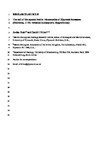The call of the squeak beetle: bioacoustics of Hygrobia hermanni (Fabricius, 1775) revisited (Coleoptera: Hygrobiidae)
| dc.contributor.author | Blair, J | |
| dc.contributor.author | Bilton, David | |
| dc.date.accessioned | 2020-02-28T12:20:12Z | |
| dc.date.available | 2020-02-28T12:20:12Z | |
| dc.date.issued | 2020-02-27 | |
| dc.identifier.issn | 0165-0424 | |
| dc.identifier.issn | 1744-4152 | |
| dc.identifier.uri | http://hdl.handle.net/10026.1/15419 | |
| dc.description.abstract |
Hygrobiidae, or squeak beetles, originated in the Triassic-Jurassic and exhibit a relictual distribution in the Palaearctic, Oriental and Australasian regions. Hygrobiids are well known for their sound-producing abilities, although studies of their bioacoustics remain limited. Here we describe sound producing organs and bioacoustics of the Palaearctic Hygrobia hermanni (Fabricius, 1775). Plectra and pars stridens were examined in both sexes, and sound characteristics analysed. Despite small differences between male and female last abdominal ventrites, plectra were identical. Pars stridens, however, differed subtly, tooth ridges being wider in females. Calls of both sexes were harmonic, with peak frequency at 6.1 kHz, and secondary peak at 10.9 kHz; males exhibiting longer inter-chirp intervals. Calls changed with time in the laboratory, this possibly condition-related effect being more apparent in males. The differences found between sexes suggest that sound production in squeak beetles may function in intraspecific communication, in addition to being an antipredator device. | |
| dc.format.extent | 1-14 | |
| dc.language | en | |
| dc.language.iso | en | |
| dc.publisher | Informa UK Limited | |
| dc.subject | Stridulation | |
| dc.subject | pars stridens | |
| dc.subject | bioacoustics | |
| dc.subject | Hygrobia hermanni | |
| dc.subject | squeak beetle | |
| dc.title | The call of the squeak beetle: bioacoustics of Hygrobia hermanni (Fabricius, 1775) revisited (Coleoptera: Hygrobiidae) | |
| dc.type | journal-article | |
| dc.type | Journal Article | |
| plymouth.author-url | https://www.webofscience.com/api/gateway?GWVersion=2&SrcApp=PARTNER_APP&SrcAuth=LinksAMR&KeyUT=WOS:000517037300001&DestLinkType=FullRecord&DestApp=ALL_WOS&UsrCustomerID=11bb513d99f797142bcfeffcc58ea008 | |
| plymouth.issue | 2 | |
| plymouth.volume | 41 | |
| plymouth.publication-status | Published | |
| plymouth.journal | Aquatic Insects | |
| dc.identifier.doi | 10.1080/01650424.2020.1726963 | |
| plymouth.organisational-group | /Plymouth | |
| plymouth.organisational-group | /Plymouth/Faculty of Science and Engineering | |
| plymouth.organisational-group | /Plymouth/Faculty of Science and Engineering/School of Biological and Marine Sciences | |
| plymouth.organisational-group | /Plymouth/REF 2021 Researchers by UoA | |
| plymouth.organisational-group | /Plymouth/REF 2021 Researchers by UoA/UoA07 Earth Systems and Environmental Sciences | |
| plymouth.organisational-group | /Plymouth/Research Groups | |
| plymouth.organisational-group | /Plymouth/Research Groups/Marine Institute | |
| plymouth.organisational-group | /Plymouth/Users by role | |
| plymouth.organisational-group | /Plymouth/Users by role/Academics | |
| dcterms.dateAccepted | 2020-02-03 | |
| dc.rights.embargodate | 2021-2-26 | |
| dc.identifier.eissn | 1744-4152 | |
| dc.rights.embargoperiod | Not known | |
| rioxxterms.versionofrecord | 10.1080/01650424.2020.1726963 | |
| rioxxterms.licenseref.uri | http://www.rioxx.net/licenses/all-rights-reserved | |
| rioxxterms.licenseref.startdate | 2020-02-27 | |
| rioxxterms.type | Journal Article/Review |


